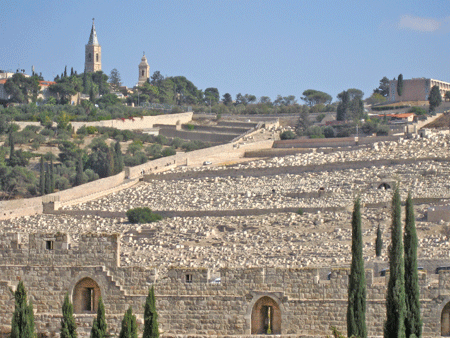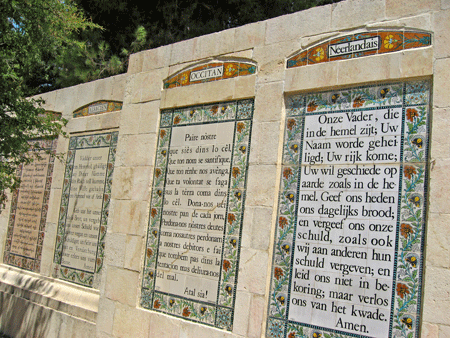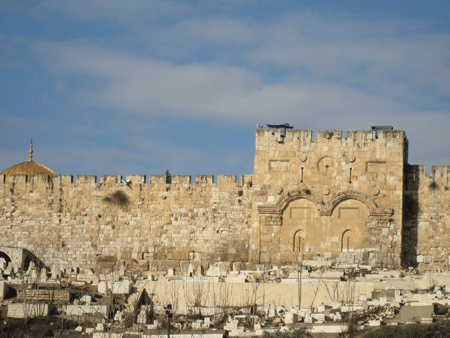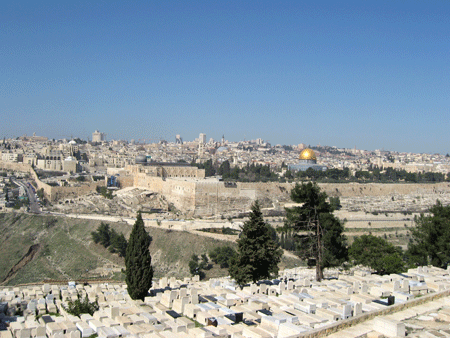|
 |
|
|
|
If you are up on the Mount of Olives on the day of
the Great Reckoning, you may witness Jesus' second
coming (Christian belief), and/or the rising of
70,000 dead from their graves, all fully dressed
(Jewish tradition). What an awesome spectacle! |
|
|
|
 |
|
Photo: Gila
Yudkin |
|
View of the Mount of Olives from
the Temple Mount |
|
|
|
But if that great day of God Almighty according to
the prophet Zechariah in which the Mount of Olives
will split, with half moving towards the north and
half moving south is delayed, then there are still a
number of fun things to experience. You can: |
|
|
- Sing as you walk down
Palm Sunday road
|
|
According to Matthew 21, when Jesus came to
Jerusalem to celebrate the Feast of Passover, he was
greeted by multitudes waving palm braches on the
Mount of Olives and shouting, "Hosanna to the Son of
David." They were demonstrating their
excitement that redemption was imminent.
(Hosanna is Aramaic for "deliver us".) When you
walk down the Mount of Olives facing the old city of
Jerusalem, sing "This is the Day that the Lord has
made" from Psalm 118, just as pilgrims did two
thousand years ago! |
|
|
|
 |
|
Photo: Gila
Yudkin |
|
Traditional "Palm Sunday Road"
leads down to the Garden of Gethsemane |
|
|
- Locate an ancient
olive tree
|
|
Actually, you won't find any, until you reach the
Garden of Gethsemane
at the foot of the Mount of Olives. That's because the Romans cut down all the olives
trees within the immediate vicinity of Jerusalem,
according to the first century AD historian Josephus
Flavius. There are, however, seven ancient olive
trees in the Garden of Gethsemane. You'll note that
if olive trees are properly pruned, they can bear
fruit for over two thousand years. If you come at
the end of October, early November, you will see the
trees dripping with olives! |
|
|
|
 |
|
Photo: Gila
Yudkin |
|
Olive tree in late October in the
Garden of Gethsemane |
|
|
- Recite the Lord's
Prayer in as many languages as you know
|
|
In the Pater Noster church, recite the Lord's prayer
in English, Spanish, French, Italian, Latin or
Swedish. There are over 100 different choices which
include Fijian, Polish and Chinese. It's believed
that Jesus hid with his disciples opposite the
Temple on the Mount of Olives and taught the Lord's
Prayer to his disciples in a cave over which the
church was built. When I'm visiting the church with
a group, I recite the Pater Noster in Hebrew and
Aramaic, two languages Jesus spoke. |
|
|
|
 |
|
Photo: Gila
Yudkin |
|
Pater Noster church displays the
Lord's Prayer in 163 languages & dialects |
|
|
- Mount a camel – but hang on tight!
|
|
Mark Twain
says that a camel would not turn out for
a king. But Shushi, who hangs out with his owner by
the panoramic view on the Mount of Olives, is more
humble. Shushi stands up with his back legs first so
you are initially rocked forward. Then, as he rises from
his front knees, you are rocked backwards. Hang
on tight! Actually, neither Shushi nor any camels
you will see in the holy land are camels. They all
have one hump, that is, they are really dromedaries. Get your camera ready for some hilarious photos! |
|
|
|
 |
|
Photo: Gila
Yudkin |
|
Mounting a camel on the Mount of
Olives in Jerusalem |
|
|
- Visit the grave of Eliezer
Ben Yehuda, reviver of the Hebrew language
|
|
In 1881, when Eliezer Ben Yehuda landed in Jaffa, he
startled his wife by announcing his intention of
reviving the dead language of Hebrew. Her response
was not recorded, but it may have been, "duh, I
don't speak Hebrew," or possibly, "hey, now I won't
understand his criticisms of my cooking!" Eliezer
Ben Yehuda took on a life-long project of inventing
a new "modern" vocabulary based upon biblical
Hebrew. As you stand by the tomb, show Ben Yehuda
that his project did indeed succeed by saying a few
Hebrew words such as "shalom Eliezer" or "Ma
shalom-ha?" (How are you doing?) See 10
handy Hebrew phrases
to learn
more…. |
|
|
|
 |
|
Photo: Gila
Yudkin |
|
Tomb of Eleazar Ben Yehuda
(middle), reviver of the Hebrew language |
|
|
- Put a stone on an old
tombstone
|
|
It's a mark of respect and a sign that the grave has
been visited. Placing a stone on a grave is an
old folk tradition whose origins
are uncertain. Perhaps because the soil on the Mount
of Olives is so rocky, burials were very close to
the surface and covered with rocks and stones. By
the time the relatives would return to commemorate
the anniversary of the death, the grave may have
been disturbed by flash-floods or animals. Therefore
family members would bring stones to rebury their
beloved. There are little openings in the tombstones
for memorial (yahrzeit) candles which burn for 24
hours. |
|
|
- See if the blocked-up
Eastern Gate is opening – just a crack
|
|
The Eastern Gate, also known as the Golden Gate was
blocked up by Muazzam Issa, Saladin's nephew (or
son-in-law, depending on which genealogy you look
at) in the early 13th century. In Jesus' day it was
opening and Christian tradition has it that Jesus
made a triumphant entry in the Temple courtyard
through this gate. Ezekiel, in chapter 44,
prophesized that the eastern gate would be shut, but
the prince of peace would enter through that gate.
So, if the gate is opening, it must mean that the
day of the great reckoning is here! |
|
|
|
 |
|
Photo: Gila
Yudkin |
|
Blocked up Eastern Gate (under the
arches), also
called the Golden Gate |
|
|
Tour the Temple
Mount in the
company of Abraham and Isaac, David and Solomon,
Jesus and the disciples, the angel Gabriel and
Mohammed. Meet many other luminaries,
both real and legendary.
Gila's Temple Mount tour
is now also available as a written
24-page PDF with a
Temple Mount plan,
guidelines for passing the security check
and ten recommended reads on the
Temple Mount from Gila's bookshelves.
|
- Pray for the peace of
Jerusalem
|
|
From time immemorial, or at least three thousand
years, pilgrims, as they come to the holy city, have
been reciting psalm 122. The psalm describes Jerusalem as
a city compact together where the tribes of Israel
ascend to the house of the Lord. You also can pray
for the peace and prosperity of Jerusalem. |
|
|
|
Shalom
for Jerusalem |
 |
|
|
|
 |
|
Photo: Gila
Yudkin |
|
Jerusalem from the Mount of Olives |
|
|
|
Copyright 2011 Gila Yudkin. Permission
needed for any reuse. |
| |
Coming to Jerusalem soon? Does the hustle and bustle of
the market give you a high, yet you would like some
quiet moments in the holy sites? Are you eager
to eat humus and knafe elbow-to-elbow with
the "natives," or is dining in the style of King
Solomon and the Queen of Sheba more to your taste?
Gila's Guide
will lift up your spirit as you "Explore
Jerusalem's Soul." This up-to-date PDF (Adobe Acrobat) 46-page
guide gives you the Top Ten places to meditate on
the Bible, the Top Ten lesser-known churches worth
visiting, the Top Ten most rewarding roof-top views
and the Top Ten places for yummy Middle Eastern soul
food. More on
Gila's Guide...
|

